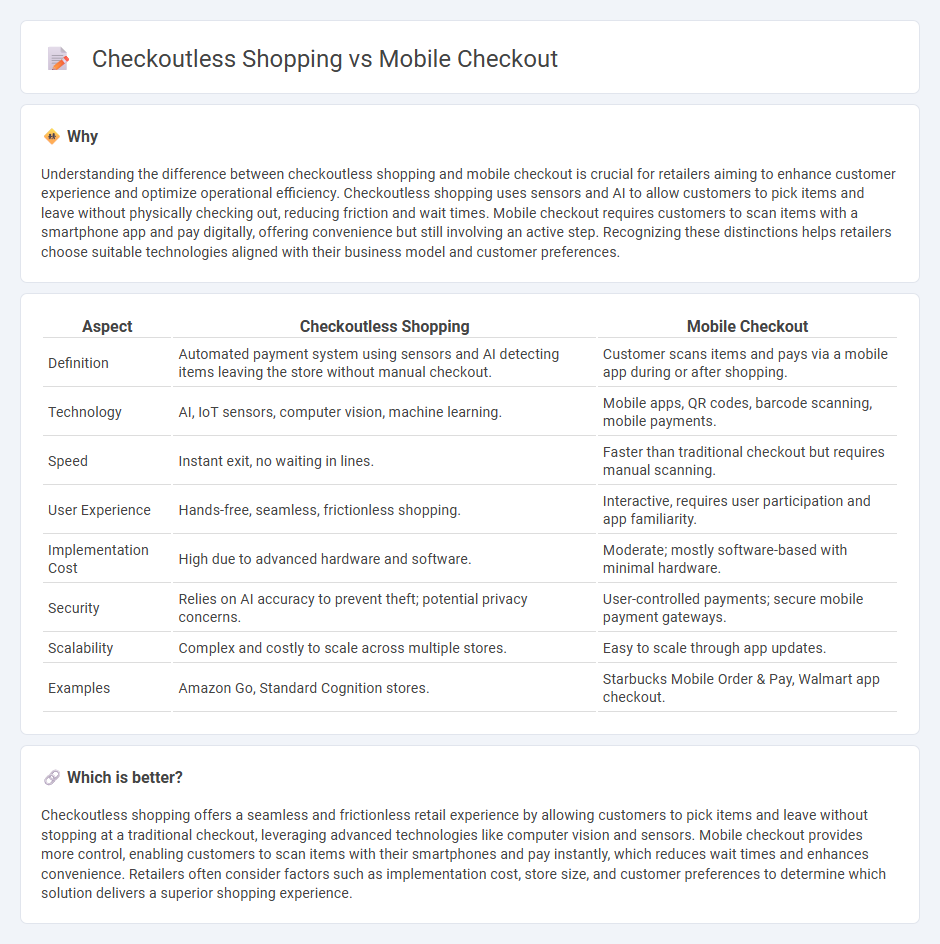
Checkoutless shopping uses advanced sensors and AI to enable customers to pick up items and leave without stopping at a register, creating a seamless and frictionless retail experience. Mobile checkout relies on customers scanning items with their smartphones and completing payment through an app, offering convenience but still requiring manual interaction. Explore how these technologies are revolutionizing retail efficiency and customer satisfaction.
Why it is important
Understanding the difference between checkoutless shopping and mobile checkout is crucial for retailers aiming to enhance customer experience and optimize operational efficiency. Checkoutless shopping uses sensors and AI to allow customers to pick items and leave without physically checking out, reducing friction and wait times. Mobile checkout requires customers to scan items with a smartphone app and pay digitally, offering convenience but still involving an active step. Recognizing these distinctions helps retailers choose suitable technologies aligned with their business model and customer preferences.
Comparison Table
| Aspect | Checkoutless Shopping | Mobile Checkout |
|---|---|---|
| Definition | Automated payment system using sensors and AI detecting items leaving the store without manual checkout. | Customer scans items and pays via a mobile app during or after shopping. |
| Technology | AI, IoT sensors, computer vision, machine learning. | Mobile apps, QR codes, barcode scanning, mobile payments. |
| Speed | Instant exit, no waiting in lines. | Faster than traditional checkout but requires manual scanning. |
| User Experience | Hands-free, seamless, frictionless shopping. | Interactive, requires user participation and app familiarity. |
| Implementation Cost | High due to advanced hardware and software. | Moderate; mostly software-based with minimal hardware. |
| Security | Relies on AI accuracy to prevent theft; potential privacy concerns. | User-controlled payments; secure mobile payment gateways. |
| Scalability | Complex and costly to scale across multiple stores. | Easy to scale through app updates. |
| Examples | Amazon Go, Standard Cognition stores. | Starbucks Mobile Order & Pay, Walmart app checkout. |
Which is better?
Checkoutless shopping offers a seamless and frictionless retail experience by allowing customers to pick items and leave without stopping at a traditional checkout, leveraging advanced technologies like computer vision and sensors. Mobile checkout provides more control, enabling customers to scan items with their smartphones and pay instantly, which reduces wait times and enhances convenience. Retailers often consider factors such as implementation cost, store size, and customer preferences to determine which solution delivers a superior shopping experience.
Connection
Checkoutless shopping relies on mobile checkout technology to enable seamless, cashier-free transactions by using sensors, cameras, and smartphone apps for automatic product detection and payment processing. Mobile checkout enhances customer convenience by allowing shoppers to scan items with their phones and complete purchases without stopping at traditional registers. The integration of mobile apps with real-time inventory systems supports a smooth retail experience, reducing wait times and improving operational efficiency.
Key Terms
Mobile Payment
Mobile payment technology streamlines mobile checkout by enabling swift, secure transactions via smartphones, reducing wait times and enhancing customer convenience. Checkoutless shopping leverages sensors and AI to automatically detect purchased items, allowing payment without manual cashier interaction, but mobile payment remains crucial for final transaction authorization. Explore how mobile payment innovations continue to transform retail experiences and boost efficiency.
RFID Sensors
Mobile checkout leverages smartphones and apps to scan items and complete payments, integrating RFID sensors to enhance scan accuracy and reduce transaction time. Checkoutless shopping employs RFID sensors embedded in store shelves and products, enabling automatic item detection and seamless payment without manual scanning or queues. Explore the advancements in RFID technology to understand how these innovations reshape the retail experience.
Computer Vision
Mobile checkout leverages smartphones to scan and pay for items, providing convenience through barcode or QR code recognition integrated with computer vision algorithms. Checkoutless shopping uses advanced computer vision systems combined with sensors to automatically track products taken by customers, eliminating the need for traditional payment lines. Explore further to understand how these technologies revolutionize retail experiences and impact consumer behavior.
Source and External Links
Mobile Checkout: Drive Sales With a Perfect Checkout Experience - Mobile checkout enables users to complete purchases smoothly on smartphones by minimizing friction points, improving UX, and reducing cart abandonment through easy payment, shipping option selection, and order confirmation optimized for mobile devices.
Mobile checkout UI: Best practices for building a better payment flow - Mobile checkout design must accommodate smaller screens and touch input, focusing on concise forms, large tap targets, and minimized user effort to ensure a user-friendly experience that differs significantly from desktop checkout.
Accept payments on-the-go Chase Mobile (r) Checkout - Chase Mobile Checkout allows sellers to accept credit card payments via smartphone and contactless card reader anywhere, supporting multiple payment methods and offering fast funding with robust security and 24/7 support.
 dowidth.com
dowidth.com